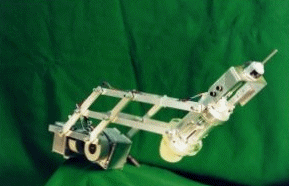High intensity focused ultrasound (HIFU)
Intense ultrasound can be used to treat tumours deep within the body (for example, deep seated brain tumours). The effect of ultrasound is to head tissue to a temperature at which it is killed, after which the dead tissue is gradually re-absorbed into the human body and removed via natually processes.
To perform tumour treatment effectively, ultrasound from a transducer must be focused to a small region within the tumour. This requires that the transducer is carefully designed to produce the appropriate beam profile leading to a tight focal point, and that the transducer is correctly positioned and aligned to put the focal point within the tumour.
To achieve alignment of transducers, a robotic approach is being adopted, mounting transducers on a robot, with a variable dimension interface matching bag between transducer and brain to allow the focal depth within the brain to be adjusted, and to provide impedance matching, allowing good transfer of energy into the brain. A project to assess the feasibilty of a robot was undertaken - the following animation shows the robot design in three positions. A more surgically applicable robot is now under development by Selvan Pather.
Because single source HIFU techniques supply a large amount of energy to the brain, there is some heating along the path of the beam in addition to the focal point. If this is sufficient, this can cause excessive tissue damage, which may, in turn, affect the properties of tissue, causing the beam focus to change. An alternative approach has been investigated by Sunita Chauhan in which multiple lower-power transducers are used together, with their focal points crossing. This method provides a similar power density at the focal point as a high power single source transducer, but the tissue along each beam is subjected to less heating, and hence, reduced possibility of damage.



